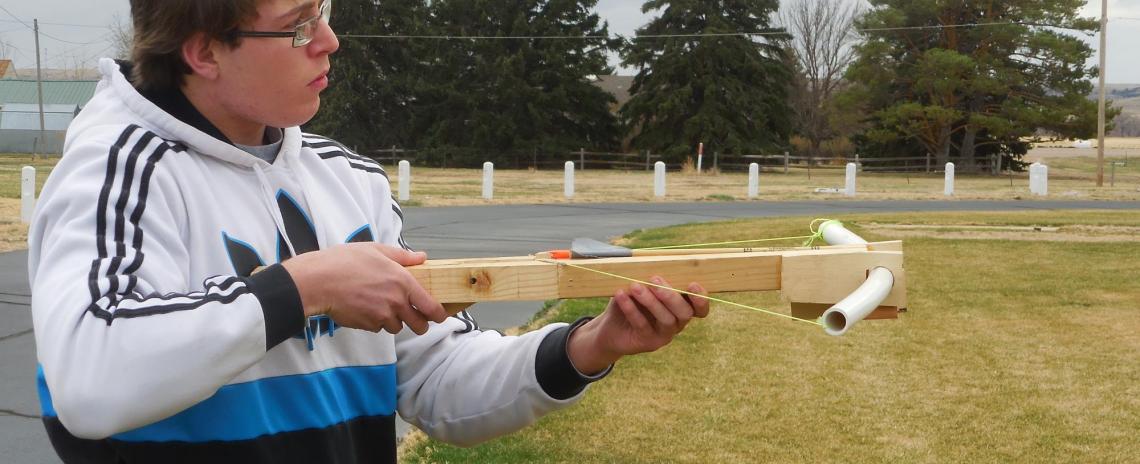The Highways of History: Garden County class takes applicable approach to the past
The Highways of History: Garden County class takes applicable approach to the past
By Tyler Dahlgren
NCSA Communications Specialist
History is vast, and the lessons within its boundaries are infinite.
To get back to 1955, Doc Brown had his DeLorean, perhaps the most famous of all sci-fi time machines. Harry Potter stumbled upon a rare Time Turner. The Flash hopped on the Cosmic Treadmill and zipped back in time to square off with Professor Zoom.
Cody Assmann has his classroom, a portal for his Garden County students to travel the highways of history, conceptualizing the past in order to better understand how things used to be and why our world works the way it does.
Assmann is heading into his seventh year at Garden County, a small school in Western Nebraska. He teaches history to students in 8th-12th grades, and up until a year ago his practices weren’t anything out of the ordinary.
“As a history teacher, we often have to give the interstate version of the material, where we are just driving through these periods, slowing down a little bit, and we’re waiving but not getting a good overview because we need to go on to the next topic and then the next,” Assmann said.
An idea came to Assman, stemming from his very own interests. The Stone Age, the Mountain Men Rendezvous period, cowboys and the settling of the West. He’d always been captivated by those eras of time, and the people who lived during them. His learning shifted from memorizing to actually doing. Building a fire, or cooking foods that cowboys cooked.
So “Living History” came to be. An applicably-charged course for juniors and seniors with a proven interest in history. A class short on PowerPoint presentations and full of hands-on learning, where students make everything from fire to aqueduct systems and engulf themselves in the fascinations of history’s greatest eras.
“We are trying to get more like the old state highway, where you pull in to town and stop at the stoplight, maybe get a bite to eat at the café where you meet some people, and really get a chance to get a feel,” Assmann said. “To really meet and mingle with the time period, that’s the general idea.”
Garden County principal Jason Spady, after a sit down with Assmann, offered nothing but support. The two ironed out details, and “Living History” was born.
“Kudos to him,” Assmann said of Spady’s administrative support. “From an administrator’s view point, it might not be an easy class to offer, because it has to be small.”
Garden County is a small school, but even a class with 20-25 students wouldn’t make logistical sense, It was important to Assmann, however, to offer an individualized learning experience to students with a vested interest. Students that wished to take all of those acquired facts and delve deeper into the history behind them.
“I appreciate, and I know the kids appreciate, his willingness to take that risk and set aside a special environment,” Assmann said. “That isn’t easy to create these days.”
The first year, while naturally experimental, was a success. Students, who picked which era to focus on, were given a quick round of basic textbook information from Assmann before being cut loose to explore on their own.
“The kids came up with the time period, I provided the basic information they needed to know, and then where their curiosities took them from there is something I didn’t try to reign in,” Assmann, who took away plenty of lessons himself in year one, said. “I had this general idea at the beginning of the year, and obviously it was a different teaching style than I’d ever done before.”
What he quickly realized was the importance of teaching skills, rather than pushing research. Analytical thinking and preparing presentations became more prevalent than information. Assmann said his students still took in the content, but the garnered skills will also stick with the kids in his class.
“Some kids learn just fine like that (through PowerPoints and note-taking), and that’s just great,” Assmann said. “Some kids who are interested don’t know where to take that beyond simple knowing, being able to rattle off a bunch of facts about a time period. They are never really taught what to do with that interest, beyond Trivial Pursuit.”
The students took quickly to the class. They’d be in first thing in the morning, without beckoning, to discuss their research with their teacher. They’d go home at night and share their discoveries with their parents, who relayed that excitement to Assmann.
“You know they are into it, especially if they are going home and telling their parents,” Assmann said. “Usually after about third grade, kids stop going home and telling their parents about what they are doing in school.”
Pretty soon, students in “Living History” started to make connections with the modern world. An understanding of how civilization has evolved through time gave way to an apprehension of why we live in the world we do now.
“If you can conceptually think about something, then all of a sudden everything applies,” Assmann said. “Because people are people, whether it’s 500 years ago or 1,000 years ago.”
History has already been written.
At Garden County, it’s ready to be explored


